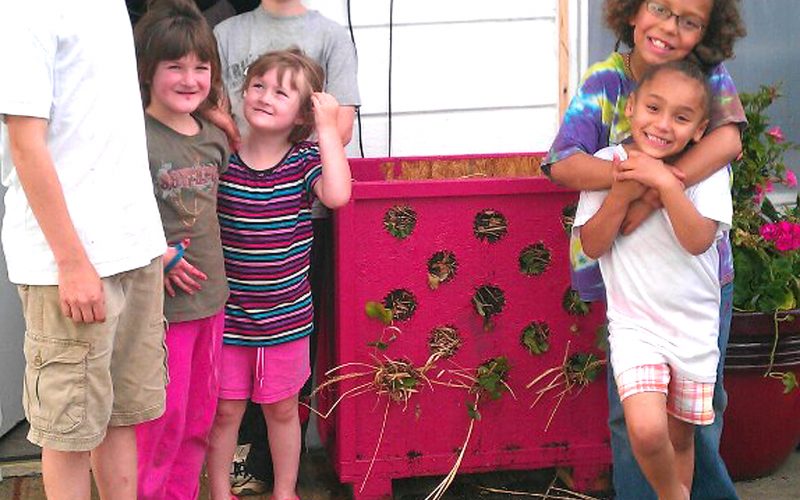
PEOPLE MAKING RIPPLES: Cindy & David Garmoe began Fayetteville’s Green Acre Eco Village as a way to restore an apartment complex into a sustainable urban community where people can rent for a year trial period, then own. The photo shows a “living wall” using a free recycled pallet, a recycled dog food bag, burlap, twine, screws, free composted grass clippings and a few plants. This is a way to garden in an area that doesn’t have access to ground space as well as providing insulation. Green Acre plans on installing rain barrels, window boxes, LED lights and solar panels, as well as diverting laundry room water for their ½ acre garden. Located at 1037 N. Main Ave. across from Drake Field, there are 7 all-electric units with six currently available. Applications are now being accepted! Contact Cindy at (479) 236-0046 for details.
By Amanda Bancroft
Anyone can live in an eco village, except Elvis Presley (despite what witnesses may say). But that doesn’t mean everyone wants to. There are benefits and drawbacks to living in an eco village, and it’s good to see both the pros and cons before making a life-altering decision. Depending on the community, eco villages offer far more rewards than downsides, and are a critical component in the fight against climate change.
Eco villages (also known as intentional communities, communes, or sustainable communities) are places in both rural and urban areas where a large or small group of people have chosen to live in proximity to one another while sharing resources, responsibilities, and a common goal. That definition is based on my personal experience and research, but many people have their own definitions ranging from “a place where crazies worship the devil” to “heaven on Earth!” One reason why eco villages get reputations along such a broad spectrum is because each individual eco village creates its own definition based on the needs of residents, while non-residents perceive each community very differently.
Some communities are completely dedicated to sustainability and preserving the environment. Other communities focus on Christianity or another religion or spiritual practice, with daily life revolves around worship and ceremony. Intentional communities are not necessarily created with religion or environmental concerns in mind, choosing instead to share services like childcare and cooking. Many of them are open and tolerant to a diversity of people, with few rules — sometimes life is highly individual, with residents having separate jobs, families and privately-owned resources. But some can have quite a few rules ranging from income sharing to restrictions on who can become a member.
Living in community is the most common-sense approach to sustaining the human species. We’re social creatures, after all, living on a planet with finite resources that are quickly being extinguished. In the current world population of over 7 billion people, do we really need over 7 billion personal vehicles, lawnmowers and televisions? It saves time and money to share resources, common spaces and responsibilities. There are also social benefits to living in a community where you know your family is supported and nurtured.
My eco village experience in 2006 at Dancing Rabbit in Rutledge, Missouri, was one of the first stepping stones on the path to creating Ripples. I learned about compost toilets, sustainable small homes and cob building, organic food, and what it was like to be eaten up to the waist by chiggers! Ripples’ earthbag headquarters may even be permanently located in an eco village someday. Dancing Rabbit and other communities worldwide are still thriving and seeking new members. For contact information and descriptions of local and distant eco villages in both urban and rural settings, check out today’s Ripples blog post!
Ripples is a blog connecting people to resources on sustainable living while chronicling their off-grid journey and supporting the work of non-profit organizations. Read more on this topic and others at www.RipplesBlog.org










